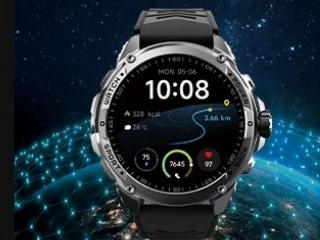- Home
- Science
- Science News
- Here's How Nuclear Clocks Could Redefine Time and Reshape Modern Technology
Here's How Nuclear Clocks Could Redefine Time and Reshape Modern Technology
Advancements in nuclear clocks using thorium-229 promise to redefine precision timekeeping, revolutionising technology.

Photo Credit: Wikimedia commons/ Isabelle Grosjean ZA
Nuclear clocks, offering measurements accurate to the 19th decimal place
Timekeeping, a cornerstone of modern technology and daily life, is poised to achieve unprecedented accuracy due to groundbreaking research in atomic and nuclear clocks. Essential for global positioning systems (GPS), telecommunications and financial networks, the definition of a "second" has evolved over centuries. The latest innovations could lead to a redefinition of the second, enhancing accuracy across numerous applications, according to recent scientific developments.
Transition from Atomic to Nuclear Clocks
As per a report by Phys.org, the current standard for measuring a second is based on electron transitions in caesium-133 atoms, with a frequency of 9,192,631,770 Hertz. While highly precise, scientists have been exploring elements with higher transition frequencies for even greater accuracy, according to several reoorts. Strontium, with a transition frequency in the visible light range, has shown promise. As per various sources, in 2021, researchers highlighted its potential and a redefinition of the second using strontium is being considered for implementation by 2030.
In September 2024, advancements in nuclear clocks were reported by a team in the United States, marking a significant step beyond atomic timekeeping. Thorium-229, an isotope with a unique nuclear transition, was utilised in these studies. This transition, excited by ultraviolet light, has a frequency approximately one million times higher than that of caesium. Reports indicate that this advancement overcomes the previous challenge of creating a frequency comb compatible with ultraviolet light, a breakthrough enabling precise measurements at this range.
Impact on Technology and Science
Nuclear clocks, offering measurements accurate to the 19th decimal place, are expected to revolutionise technologies reliant on precision, as per reports. Applications include refined GPS systems, advanced scientific research and insights into phenomena governed by quantum mechanics and general relativity. Researchers have emphasised the potential for these clocks to enhance the measurement of ultra-fast processes, a critical factor in fields like physics and space exploration.
While caesium remains the standard for now, the strides made with thorium-229 suggest a transformative future for timekeeping technology, with far-reaching implications for science and industry, as per reports.
Get your daily dose of tech news, reviews, and insights, in under 80 characters on Gadgets 360 Turbo. Connect with fellow tech lovers on our Forum. Follow us on X, Facebook, WhatsApp, Threads and Google News for instant updates. Catch all the action on our YouTube channel.
Related Stories
- Samsung Galaxy Unpacked 2025
- ChatGPT
- Redmi Note 14 Pro+
- iPhone 16
- Apple Vision Pro
- Oneplus 12
- OnePlus Nord CE 3 Lite 5G
- iPhone 13
- Xiaomi 14 Pro
- Oppo Find N3
- Tecno Spark Go (2023)
- Realme V30
- Best Phones Under 25000
- Samsung Galaxy S24 Series
- Cryptocurrency
- iQoo 12
- Samsung Galaxy S24 Ultra
- Giottus
- Samsung Galaxy Z Flip 5
- Apple 'Scary Fast'
- Housefull 5
- GoPro Hero 12 Black Review
- Invincible Season 2
- JioGlass
- HD Ready TV
- Laptop Under 50000
- Smartwatch Under 10000
- Latest Mobile Phones
- Compare Phones
- Xiaomi 17 Ultra Leica Edition
- Xiaomi 17 Ultra
- Huawei Nova 15
- Huawei Nova 15 Pro
- Huawei Nova 15 Ultra
- OnePlus 15R
- Realme Narzo 90x 5G
- Realme Narzo 90 5G
- Asus ProArt P16
- MacBook Pro 14-inch (M5, 2025)
- OPPO Pad Air 5
- Huawei MatePad 11.5 (2026)
- Huawei Watch 10th Anniversary Edition
- OnePlus Watch Lite
- Acerpure Nitro Z Series 100-inch QLED TV
- Samsung 43 Inch LED Ultra HD (4K) Smart TV (UA43UE81AFULXL)
- Asus ROG Ally
- Nintendo Switch Lite
- Haier 1.6 Ton 5 Star Inverter Split AC (HSU19G-MZAID5BN-INV)
- Haier 1.6 Ton 5 Star Inverter Split AC (HSU19G-MZAIM5BN-INV)
-
 Lenovo Watch GT Pro Launched With 1.43-Inch Display, SpO2 Monitor: Price, Specifications
Lenovo Watch GT Pro Launched With 1.43-Inch Display, SpO2 Monitor: Price, Specifications
-
 Stranger Things Season 5 Volume 2 Now Streaming on Netflix: What You Need to Know
Stranger Things Season 5 Volume 2 Now Streaming on Netflix: What You Need to Know
-
 Madden OTT Release Date Revealed: When and Where to Watch John Madden’s Starrer Online?
Madden OTT Release Date Revealed: When and Where to Watch John Madden’s Starrer Online?
-
 OnePlus Turbo Series Launch Teased, Pre-Orders Open in China: See Expected Specifications
OnePlus Turbo Series Launch Teased, Pre-Orders Open in China: See Expected Specifications










